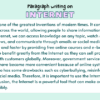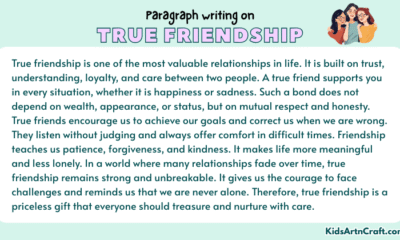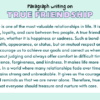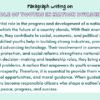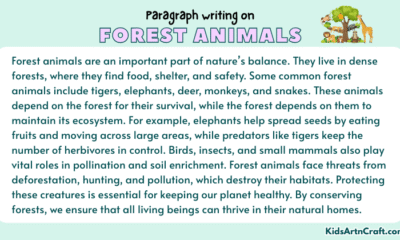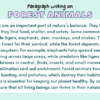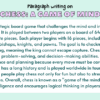Paragraph Writing
Paragraph on Natural Disasters
This activity will help us practice writing paragraphs on “Natural Disasters” in multiple forms — Expository, Persuasive, Descriptive, and Narrative — and structure them effectively using PEEL, TEEL, TEXAS, and the Hamburger Method.
Most of our paragraphs are in 150 to 200 words. You can also find longer paragraphs (in 300 words) on ‘Natural Disasters’ or essays on the same topic on the web.
Different Styles of Paragraphs on ‘Natural Disasters’
1. Expository Paragraph on Natural Disasters (Explains with Facts)
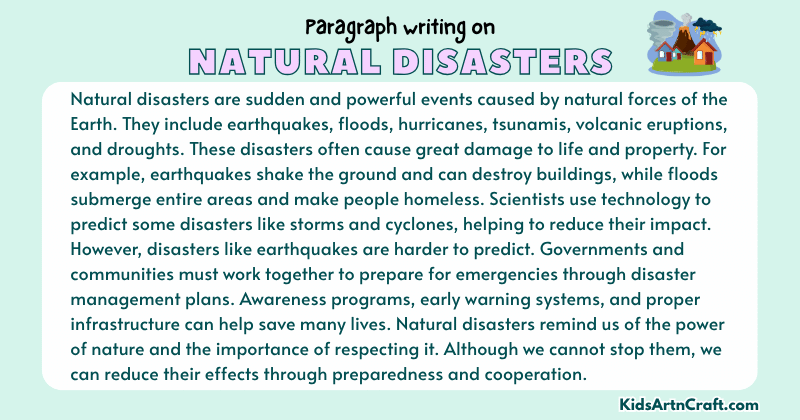
Natural disasters are sudden and powerful events caused by natural forces of the Earth. They include earthquakes, floods, hurricanes, tsunamis, volcanic eruptions, and droughts. These disasters often cause great damage to life and property. For example, earthquakes shake the ground and can destroy buildings, while floods submerge entire areas and make people homeless. Scientists use technology to predict some disasters like storms and cyclones, helping to reduce their impact. However, disasters like earthquakes are harder to predict. Governments and communities must work together to prepare for emergencies through disaster management plans. Awareness programs, early warning systems, and proper infrastructure can help save many lives. Natural disasters remind us of the power of nature and the importance of respecting it. Although we cannot stop them, we can reduce their effects through preparedness and cooperation.
2. Persuasive Paragraph on Natural Disasters (Tries to Convince You)
We must take natural disasters seriously and act to reduce their impact. Every year, thousands of people lose their homes and lives because of floods, earthquakes, and cyclones. Many of these tragedies can be prevented if we prepare in advance. Governments should invest in strong infrastructure, better drainage systems, and early warning technologies. Schools should educate students about safety steps during disasters. Communities must also take responsibility by planting more trees, avoiding plastic waste, and keeping the environment clean, as climate change worsens many disasters. Ignoring these dangers will only increase suffering. If we work together—citizens, scientists, and leaders—we can protect our planet and ourselves. Let us not wait for another disaster to remind us of our duty. Preparedness today can save countless lives tomorrow.
3. Descriptive Paragraph on Natural Disasters (Paints a Picture with Words)
When a natural disaster strikes, nature shows its most powerful and frightening side. The sky darkens, winds roar, and the ground trembles. During a flood, muddy waters rush through streets, carrying away everything in their path. In an earthquake, buildings shake, and people run in fear as the earth rumbles beneath their feet. A volcanic eruption paints the sky red with smoke and lava. After the storm passes, silence fills the air, broken only by cries for help and the sound of rescue teams. The sight of fallen trees, broken homes, and flooded fields fills hearts with sadness. Yet, amid the destruction, hope rises when people come together to help one another. Natural disasters remind us of the beauty and power of nature—and our need to respect and protect it.
4. Narrative Paragraph on Natural Disasters (Tells a Story)
Last year, my town faced a terrible flood after days of nonstop rain. At first, the streets were filled with water, and we thought it would soon stop. But by the second day, the water rose quickly, entering our homes. My family and I moved to the roof for safety as rescue boats arrived. I remember the fear in my heart as I saw cars floating away and neighbors calling for help. Volunteers came with food and blankets, and we stayed in a relief camp for several days. Despite the chaos, everyone helped each other. People shared meals, comforted children, and worked together to clean up after the flood. When the water finally went down, our town was damaged, but our spirit remained strong. That disaster taught me the value of kindness, unity, and preparedness.
‘Natural Disasters‘ Paragraphs in Different Structured Methods
1. Natural Disasters Paragraph Writing with PEEL Method
PEEL Method (Point, Evidence, Explanation, Link)

Point: Natural disasters are powerful events caused by nature.
Evidence: For example, when an earthquake happens, the ground shakes, and buildings can fall down. Floods fill streets with water and make people leave their homes.
Explanation: They include earthquakes, floods, cyclones, and volcanic eruptions. These disasters can destroy homes, trees, and even lives.
Link: Natural disasters remind us that nature is very strong. We cannot stop them, but we can be prepared. By learning safety rules and helping others, we can stay safe and protect our community.
2. Natural Disasters Paragraph Writing with TEEL Method
TEEL Method (Topic, Evidence, Explanation, Link)
Topic: Natural disasters are sudden events that cause great harm to people and nature.
Evidence: For example, when a cyclone hits, strong winds and heavy rain destroy houses and trees.
Explanation: These disasters, such as tsunamis, droughts, and earthquakes, occur due to natural forces. They can damage land, buildings, and animals’ homes.
Link: It is important to learn how to face natural disasters calmly. Safety drills, early warnings, and teamwork can help people stay safe and reduce loss.
3. Natural Disasters Paragraph Writing with the TEXAS Method
TEXAS Method (Topic, Example, Explanation, Analysis, Summary/Significance)
Topic: Natural disasters are dangerous events caused by nature.
Example: For instance, a flood can cover cities with water, while a volcano can erupt with hot lava.
Explanation: They happen when natural forces like wind, water, or earth become very strong.
Analysis: These disasters harm people, animals, and the environment. But if we stay alert and follow safety rules, we can protect ourselves.
Summary: Natural disasters are powerful, but being prepared helps us stay safe and brave.
4. Natural Disasters Paragraph Writing with Hamburger Method
Hamburger Method (Top Bun, The Fillings, Bottom Bun)
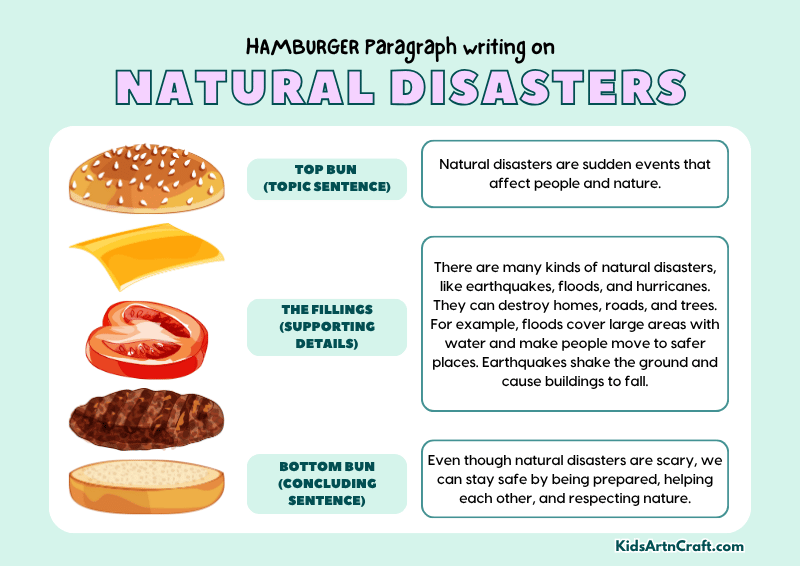
Top Bun (Topic Sentence):
Natural disasters are sudden events that affect people and nature.
The Fillings (Supporting Details):
There are many kinds of natural disasters, like earthquakes, floods, and hurricanes. They can destroy homes, roads, and trees. For example, floods cover large areas with water and make people move to safer places. Earthquakes shake the ground and cause buildings to fall.
Bottom Bun (Concluding Sentence):
Even though natural disasters are scary, we can stay safe by being prepared, helping each other, and respecting nature.
Hope you liked these paragraphs on ‘Natural Disasters’. Don’t forget to join the Telegram group for FREE Printables.
Check this article to know about types of disasters flashcards – printable matching activities for kids.




